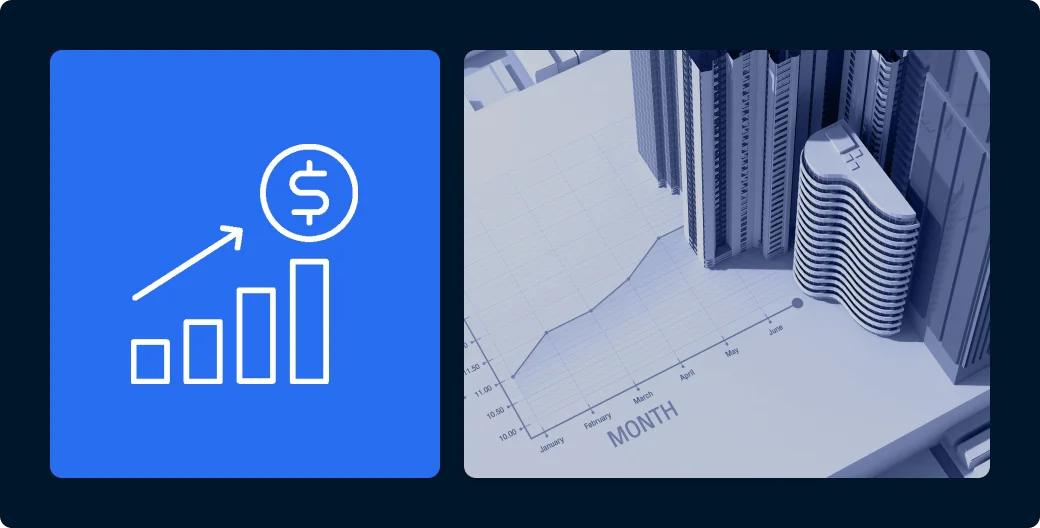As interest rates stabilize and capital flows rebound, 2025 is shaping up to be a pivotal year for commercial real estate (CRE) lending. However, staying competitive requires keeping up with the latest trends.
Current market activity and lending momentum
Commercial real estate lending activity is on the rise.
The CBRE Lending Momentum Index, which tracks the pace of CBRE-originated commercial loan closings in the U.S., surged in Q1 2025. It jumped 13% quarter-over-quarter and 90% year-over-year, driven by higher financing volumes and robust activity from banks.
How commercial real estate interest rates are shaping lending dynamics
Part of what’s driving commercial real estate lending activity is stabilizing interest rates. Over the past year, the prime rate, a benchmark rate that commercial banks charge their most creditworthy customers, remained mostly steady and even dropped by 1%.
As a result, interest rate uncertainty has calmed, leading to more borrowing and refinancing activity. Meanwhile, an uptick in investor demand for CRE debt has helped compress cap rates and boost property values. In fact, CRE values have been steadily rising since the start of 2024.
Rise of non-bank lending and private debt
Another reason CRE lending is on the upswing is the rise of non-bank and private debt.
Alternative lenders gaining market share
In Q4 2024, life companies were the second most active lending group after banks, accounting for 33% of non-agency loan closings. They were followed by debt funds and mortgage REITs, which had a 23% share, and CMBS conduits, which accounted for the remaining 1.5%.
Flexibility in deal structure and LTV models
Compared to agency debt, private loans are more flexible in how they’re structured. For example, lenders may underwrite based on the asset-level cash flow or a maximum loan-to-value (LTV) ratio, rather than the borrower’s balance sheet or credit history.
Collaborations between banks and fintechs
Some banks are starting to embrace fintech solutions to streamline the borrowing process. For example, Blooma helps lenders streamline complex lending processes with AI. Similarly, Agora helps sponsors raise investor capital faster and more easily with purpose-built software.
Technology, AI, and digital transformation in lending
It’s no secret that tech and AI are transforming the lending space. From AI aiding in underwriting loans to software disbursing funds online, the entire loan life cycle has become digital. This not only streamlines lending but saves money through automation and self-service tools.
ESG and sustainable financing trends
Sustainable building standards like ESG are becoming increasingly important in lenders’ underwriting decisions.
ESG-linked lending and premiums
Some lenders promote sustainability by imposing green development standards on borrowers as part of the loan terms. These are called sustainability-linked loans (SLLs). However, borrowers may pay a “green premium” for the extra costs associated with sustainable building methods.
Green loans and sustainability reporting
Regulatory incentives help drive demand for green loans. For example, many property owners must report their emissions levels to the government. A green loan that rewards low emissions can help align lenders with operators.
Net-zero financing commitments
Some lenders pledge only to fund portfolios that emit net-zero carbon emissions. While this can result in higher construction and operating costs, it can also help owners and securitizers raise more capital from environmentally-focused real estate investors.
Property type–specific lending outlook
Commercial real estate lending trends vary by property type:
1. Office
In Q1 2025, an average of about 62 office properties transacted per day, far below the pre-pandemic level of around 80. However, the median transaction size in dollar terms was up 25.2% year-over-year. Since most commercial real estate deals leverage debt, this means more dollars are financing offices per transaction compared to last year.
2. Industrial
On average, 54 industrial properties transacted per day in Q1 2025, well below historical levels since the pandemic. Meanwhile, the median transaction size in dollar terms was up 14.1% year-over-year.
3. Multifamily
An average of about 106 multifamily properties traded per day in Q1 2025, roughly in line with the same period last year. However, the median transaction size in dollar terms was up 6.3% year-over-year.
4. Retail
On average, around 87 retail properties were transacted per day in Q1 2025. Like other property types, however, the median transaction size for retail deals was up. It increased by 8.8% year-over-year, indicating more financing dollars per sale.
5. Hospitality
Only 5 hospitality properties transacted on an average day in Q1 2025, well below the 25-year average of 9. However, the median transaction size in dollar terms was up 11%, a positive sign for the hospitality industry.
6. Mixed-use and other commercial property types
On average, around 53 mixed-use and other commercial property types were transacted daily in Q1 2025. Meanwhile, the median transaction size in dollar terms was up slightly by 2.9% from the same period last year.
Credit quality and delinquency trends
While commercial real estate financing activity is up, so are loan delinquencies. In Q4 2024, the CRE loan delinquency rate rose to 1.57%, the highest rate in a decade. This rate suggests there was over $47.15 billion in delinquent loans.
Meanwhile, the charge-off rate, the percentage of loans that banks write off as uncollectible, has risen only modestly to 0.26%, which represents about $7.8 billion in loans. In other words, banks have been reluctant to accept losses.
Regulatory and securitization developments
Here are some regulatory and securitization developments poised to impact commercial real estate lending:
EU easing securitization to boost lending
The European Commission recently proposed to loosen the EU’s overly strict securitization rules for banks. If successful, this could free up more capital for lending across different industries, including CRE.
U.S. bank exits and capital reallocations
Many banks are trying to limit their exposure to CRE loan risk. Some have hedged risk by selling off blocks of loans using Synthetic Risk Transfers (SRTs), while private lenders and debt funds are filling the gap, capitalizing on banks’ retreat from CRE lending.
Stress on LTV and debt-service coverage
Compressed cap rates and rising property values are putting stress on loan-to-value (LTV) ratios. To mitigate default risk, lenders must focus on cash flow durability and debt-service coverage ratios (DSCR) more than ever.
Positive commercial real estate lending trends in 2025
Fortunately, real estate lending has a lot going for it in 2025:
- Lower cost of borrowing. With interest rates stabilizing and even falling slightly, borrowing becomes less expensive. This encourages acquisitions and development.
- Boost to investor confidence and demand. A stabilizing CRE market boosts investors’ confidence that the market today will look similar to the market tomorrow.
- Refinancing opportunities. With 20% ($957 billion) of $4.8 trillion in outstanding commercial mortgages coming due in 2025, many owners will be looking to refinance their debt, especially if interest rates continue to fall.
- Economic growth and job creation. As the economy continues to grow and create jobs, tenant demand for commercial properties will, too.
- Loan-to-value and debt-service ratios. More and more lenders are focusing on property-level metrics like LTV and DSCR in underwriting decisions, opening the door for more sponsors to qualify for debt financing.
Risks for lenders and borrowers
Of course, commercial real estate lending and borrowing come with risks. Here are the top risks to watch in 2025:
| Risk factor | Description |
| Economic uncertainty and policy volatility | From tariffs to taxes to the Federal Funds Rate, U.S. economic policies can be volatile and hard to predict. That’s why rising interest rates and changes in tax policies were among the top financial concerns cited by CRE investors. |
| Rising delinquencies and loan performance concerns | With the CRE loan delinquency rate steadily rising, lenders and borrowers must be extra cautious when underwriting and performing due diligence. |
| Office market distress and long-term occupancy risks | Remote and hybrid work are here to stay. This has dampened demand for offices and lowered their occupancy rates, raising the risk of loan defaults by real estate owners. |
| Structural shifts in work models affecting property demand | Downsizing and flex space trends are changing the types of properties tenants want, impacting returns for investors. |
| Reduced risk appetite from traditional lenders | Conventional banks are wary of a market correction that could leave them overexposed to the CRE industry. |
| Potential regulatory tightening and capital requirements | Ever since the 2008 financial crisis, regulators have tightened bank lending requirements, making it harder to qualify for CRE loans. |
| Market concentration in certain asset classes | Overexposure to any single asset class, such as multifamily or industrial properties, could lead to significant loss if the sector experiences a downturn. |
| Debt maturity walls and refinancing gaps | Looming loan expirations amid tighter credit availability may lead to refinancing gaps for real estate owners. |
Best practices in lending strategies
To optimize debt performance, follow these lending best practices:
- Leverage data-driven underwriting with AI/analytics. This helps you better assess risk based on real-time market trends and borrower behavior.
- Prioritize tech and automation. They can streamline tasks like document processing, credit evaluation, and loan servicing. That way, you can save time and minimize human errors.
- Adopt ESG standards and reporting systems. Integrating ESG criteria and reporting into lending decisions aligns you with evolving investor priorities and regulatory expectations.
- Implement flexible term structuring and refinancing playbooks. Creating flexible loan structures, such as interest-only periods and extension options, helps mitigate borrower risk during market shifts.
- Partner with fintech for operational efficiency. Collaborating with fintech platforms can help you digitize workflows, improve borrower onboarding, access real-time performance data, and ultimately scale your financing operations.
Conclusion
2025 isn’t just a rebound year for commercial real estate lending. It’s a reset. As capital returns and new tools reshape the market, success will belong to those who adapt fast and think beyond the traditional way of doing things, whether you’re a borrower or a lender.
As you focus on leveraging commercial real estate debt, don’t forget to optimize how you raise equity funds, too. With a robust investment management platform, you can streamline capital raising to shorten funding periods and improve investor relations.










